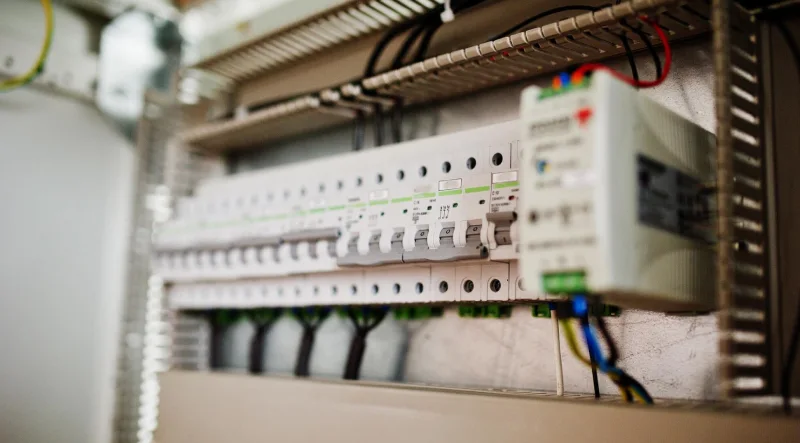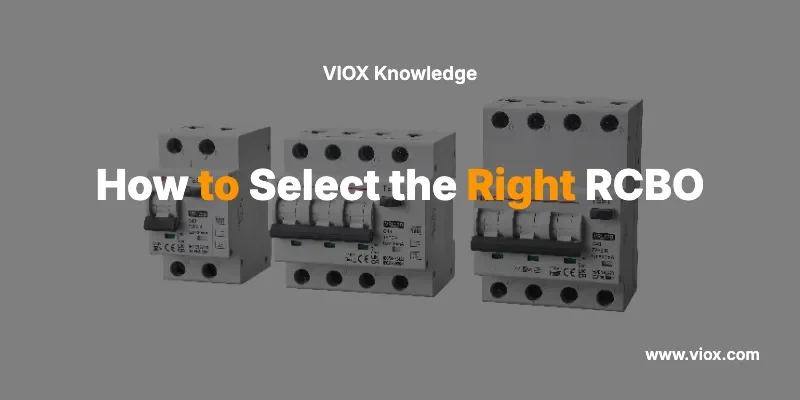การเลือก RCBO (เบรกเกอร์ป้องกันกระแสเกิน) ที่เหมาะสมเป็นสิ่งสำคัญอย่างยิ่งยวดเพื่อให้มั่นใจถึงความปลอดภัยทางไฟฟ้าสูงสุดและเป็นไปตามมาตรฐาน คู่มือฉบับสมบูรณ์นี้จะช่วยให้ช่างไฟฟ้า ผู้รับเหมา และผู้ที่ชื่นชอบงาน DIY มีวิธีการเลือก RCBO ที่เหมาะสมที่สุดสำหรับการใช้งานทุกประเภทอย่างเป็นระบบ
RCBO คืออะไร และเหตุใดการเลือกที่เหมาะสมจึงสำคัญ

หนึ่ง RCBO รวมฟังก์ชันการป้องกันของเบรกเกอร์วงจรขนาดเล็ก (MCB) และอุปกรณ์ป้องกันไฟรั่ว (RCD) ไว้ในหน่วยเดียว ฟังก์ชันการทำงานแบบคู่นี้ทำให้ การเลือก RCBO สำคัญสำหรับ:
- การคุ้มครองความปลอดภัยส่วนบุคคล ป้องกันไฟฟ้าช็อต
- ไฟ prevention ผ่านการตรวจจับความผิดพลาดของดิน
- อุปกรณ์ป้องกัน จากความเสียหายจากกระแสไฟเกิน
- รทำตามข้อตกล ด้วยกฎระเบียบด้านไฟฟ้าที่ทันสมัย
- ประสิทธิภาพการใช้พื้นที่ ในหน่วยผู้บริโภค
บรรทัดล่าง: การเลือกประเภทหรือค่าการจัดอันดับ RCBO ที่ไม่ถูกต้องอาจส่งผลต่อความปลอดภัย ทำให้เกิดการสะดุดที่ก่อให้เกิดความรำคาญ หรือไม่เป็นไปตามข้อกำหนดด้านกฎระเบียบ
เกณฑ์การเลือก RCBO ที่สำคัญ
การเลือกอัตราปัจจุบัน
การ พิกัดกระแส RCBO จะต้องตรงตามข้อกำหนดของวงจรของคุณ:
ขั้นตอนที่ 1: คำนวณโหลดวงจร
- รวมคะแนนเครื่องใช้ไฟฟ้าที่เชื่อมต่อทั้งหมด
- การประยุกต์ใช้ปัจจัยความหลากหลายสำหรับวงจรไฟส่องสว่าง (66%)
- พิจารณาการขยายโหลดในอนาคต (เพิ่มระยะขอบความปลอดภัย 25%)
ขั้นตอนที่ 2: จับคู่ความจุสายเคเบิล
- สายเคเบิลขนาด 2.5 มม.²: สูงสุด 20A RCBO
- สายเคเบิลขนาด 1.5 มม.²: สูงสุด 16A RCBO
- สายเคเบิล 1.0 มม.²: สูงสุด 6A RCBO
ขั้นตอนที่ 3: พิจารณาประเภทแอปพลิเคชัน
- วงจรไฟฟ้าแสงสว่าง : โดยทั่วไป 6A หรือ 10A ก็เพียงพอ
- เต้ารับไฟฟ้า: 16A หรือ 20A สำหรับบ้าน 32A สำหรับเชิงพาณิชย์
- เครื่องใช้ไฟฟ้าเฉพาะ: ตรงกับระดับเครื่องใช้ไฟฟ้า (เตา 32A-45A)
การเลือกประเภท RCBO (ฟังก์ชัน RCD)
การติดตั้งสมัยใหม่ต้องพิจารณาอย่างรอบคอบ ประเภท RCBO โดยอิงตามโหลดที่เชื่อมต่อ:
ประเภท AC RCBO (รุ่นดั้งเดิม – ไม่แนะนำ)
- ตรวจจับกระแสไฟฟ้าตกค้าง AC บริสุทธิ์เท่านั้น
- ไม่เหมาะกับโหลดอิเล็กทรอนิกส์สมัยใหม่
- กำลังถูกยกเลิกภายใต้กฎระเบียบปัจจุบัน
RCBO แบบ A (มาตรฐานปัจจุบัน)
- ตรวจจับกระแสไฟฟ้าสลับและกระแสตรงแบบพัลซิ่ง
- จำเป็นสำหรับวงจรที่มีอุปกรณ์อิเล็กทรอนิกส์
- ข้อกำหนดขั้นต่ำภายใต้ BS 7671:2018
- ดีที่สุดสำหรับ: วงจรไฟฟ้าภายในบ้านและเชิงพาณิชย์ทั่วไป
RCBO ชนิด B (การใช้งานเฉพาะทาง)
- ตรวจจับกระแส AC + กระแส DC แบบพัลซิ่ง + กระแส DC แบบเรียบ
- สิ่งสำคัญสำหรับ: จุดชาร์จรถยนต์ไฟฟ้า ระบบโซลาร์เซลล์ PV
- จำเป็นเมื่อ: กระแสไฟ DC รั่วไหลได้
- ต้นทุนสูงกว่าแต่สำคัญสำหรับการใช้งานเฉพาะ
การเลือกเส้นโค้งการเดินทาง (ฟังก์ชัน MCB)
การ ลักษณะกระแสเกิน กำหนดว่า RCBO ตอบสนองต่อการโอเวอร์โหลดได้เร็วแค่ไหน:
เส้นโค้งประเภท B (กระแสไฟฟ้าที่กำหนด 3-5 เท่า)
- การใช้งาน: ไฟบ้าน ปลั๊กไฟทั่วไป
- ระยะการเดินทาง: 30A-50A สำหรับอุปกรณ์ 10A
- ดีที่สุดสำหรับ: โหลดต้านทานที่มีกระแสไฟฟ้ากระชากต่ำ
เส้นโค้งประเภท C (กระแสไฟฟ้าที่กำหนด 5-10 เท่า)
- การใช้งาน: วงจรเชิงพาณิชย์/อุตสาหกรรม
- ระยะการเดินทาง: 50A-100A สำหรับอุปกรณ์ 10A
- ดีที่สุดสำหรับ: โหลดเหนี่ยวนำ วงจรมอเตอร์บางวงจร
เส้นโค้งประเภท D (กระแสไฟฟ้าที่กำหนด 10-20 เท่า)
- การใช้งาน: อุปกรณ์กระแสไฟกระชากสูง
- ระยะการเดินทาง: 100A-200A สำหรับอุปกรณ์ 10A
- ดีที่สุดสำหรับ: หม้อแปลงไฟฟ้า มอเตอร์ขนาดใหญ่ อุปกรณ์เอ็กซ์เรย์

กระบวนการเลือก RCBO ทีละขั้นตอน
ขั้นตอนที่ 1: การประเมินการสมัคร
1. ระบุวัตถุประสงค์ของวงจร
- วงจรไฟส่องสว่าง → Type B, 6A-10A, Type A
- ปลั๊กไฟทั่วไป → Type B, 16A-20A, Type A
- เครื่องใช้ไฟฟ้าในครัว → Type B, 16A-32A, Type A
- การชาร์จ EV → ประเภท B, 32A, ประเภท B
- โซลาร์ PV → ประเภท B, แตกต่างกัน, ประเภท B
2. ตรวจสอบสภาพแวดล้อม
- สถานที่แห้งในร่ม: ความไวมาตรฐาน (30mA)
- พื้นที่เปียก (ห้องน้ำ): 30mA พร้อมพิจารณาเพิ่ม 10mA
- วงจรกลางแจ้ง: จำเป็นต้องมีตู้ที่ทนทานต่อสภาพอากาศ
3. ตรวจสอบการติดตั้งที่มีอยู่
- ประเภทระบบสายดิน (TN-CS, TT, IT)
- พื้นที่ว่างในหน่วยผู้บริโภค
- การประสานงานอุปกรณ์ป้องกันที่มีอยู่
ระยะที่ 2: ข้อมูลจำเพาะทางเทคนิค
1. ความไวต่อกระแสไฟตกค้าง
- 30มิลลิแอมป์: มาตรฐานสำหรับวงจรสุดท้าย
- 300มิลลิแอมป์: ระบบป้องกันอัคคีภัยเท่านั้น (อุปกรณ์ต้นทาง)
- 10มิลลิแอมป์: สถานที่พิเศษ (พื้นที่ทางการแพทย์)
2. ความสามารถในการป้องกันไฟฟ้าลัดวงจร
- 6kA: การติดตั้งภายในบ้านทั่วไป
- 10kA: การใช้งานเชิงพาณิชย์/อุตสาหกรรม
- ตรงกันหรือเกินกระแสไฟฟ้าขัดข้องที่อาจเกิดขึ้น
3. การกำหนดค่าเสา
- เสาเดี่ยว: ระบบ TN-CS (การป้องกันสาย)
- ขั้วเดี่ยว + นิวทรัล: ระบบ TT วงจร EV
- เสาคู่: สามปั่นป่วนเท่าเรื่องโปรแกรม
ขั้นตอนที่ 3: การตรวจสอบการปฏิบัติตาม
1. ข้อกำหนดด้านกฎระเบียบ
- การปฏิบัติตามมาตรฐาน BS 7671:2018 ฉบับที่ 18
- ข้อบังคับอาคาร ส่วนที่ P
- การรับรองจากผู้ผลิต (BEAB, SEMKO)
2. มาตรฐานการติดตั้ง
- การตรวจสอบการเชื่อมต่อด้านโหลดที่ถูกต้อง
- ข้อกำหนดความสมบูรณ์ที่เป็นกลาง
- การประสานงานกับอุปกรณ์ต้นทาง
RCBO เทียบกับวิธีการป้องกันทางเลือก
| วิธีการป้องกัน | กระแสไฟเกิน | รอยเลื่อนดิน | พื้นที่ที่ใช้ | ค่าใช้จ่าย | แอปพลิเคชั่นที่ดีที่สุด |
|---|---|---|---|---|---|
| RCBO | ✓ | ✓ | 1 โมดูล | สูง | การป้องกันวงจรแบบแยกส่วน |
| เอ็มซีบี + อาร์ซีดี | ✓ | ✓ | 2+ โมดูล | ปานกลาง | การป้องกันวงจรหลายวงจร |
| เฉพาะ MCB เท่านั้น | ✓ | ✗ | 1 โมดูล | ต่ำ | วงจรที่ไม่สำคัญ |
| RCD เท่านั้น | ✗ | ✓ | 2 โมดูล | ต่ำ | การป้องกันไฟฟ้าลัดวงจรเท่านั้น |

ข้อผิดพลาดในการเลือกทั่วไปที่ควรหลีกเลี่ยง
ข้อผิดพลาดที่ 1: เลือกประเภท RCD ผิด
ปัญหา: การใช้ RCBO แบบ AC กับโหลดอิเล็กทรอนิกส์
สารละลาย: ระบุประเภท A ขั้นต่ำสำหรับการติดตั้งสมัยใหม่เสมอ
ค่าใช้จ่าย: ความเสี่ยงด้านความปลอดภัยที่อาจเกิดขึ้นและการไม่ปฏิบัติตาม
ข้อผิดพลาดที่ 2: กระแสไฟเกินขนาด
ปัญหา: การสะดุดที่น่ารำคาญระหว่างการทำงานปกติ
สารละลาย: การคำนวณโหลดที่เหมาะสมรวมถึงปัจจัยความหลากหลาย
ค่าใช้จ่าย: การโทรให้บริการและความไม่พอใจของลูกค้า
ข้อผิดพลาดที่ 3: การละเลยข้อกำหนดในอนาคต
ปัญหา: ติดตั้ง RCBO แบบ A ในพื้นที่ที่วางแผนจะชาร์จรถยนต์ไฟฟ้า
สารละลาย: พิจารณาความต้องการ EV/พลังงานแสงอาทิตย์ในอนาคต – ติดตั้ง Type B
ค่าใช้จ่าย: การอัพเกรดในอนาคตที่มีราคาแพง
ข้อผิดพลาดที่ 4: การประสานงานที่ไม่ดี
ปัญหา: RCBO ไม่เลือกปฏิบัติกับอุปกรณ์ต้นทาง
สารละลาย: ตรวจสอบคุณลักษณะของเวลาและกระแสเพื่อการเลือกที่เหมาะสม
ค่าใช้จ่าย: ไฟฟ้าดับโดยไม่จำเป็น ส่งผลกระทบต่อวงจรหลายวงจร
ข้อควรพิจารณาในการติดตั้งและการทดสอบ
รายการตรวจสอบก่อนการติดตั้ง
- ตรวจสอบให้แน่ใจว่าแหล่งจ่ายไฟถูกตัดการเชื่อมต่อและล็อคไว้
- ยืนยันว่าข้อกำหนด RCBO ตรงตามข้อกำหนด
- ตรวจสอบพื้นที่หน่วยผู้บริโภคและความเข้ากันได้ของบัสบาร์
- เตรียมเครื่องมือและอุปกรณ์ทดสอบที่เหมาะสม
การทดสอบหลังการติดตั้ง
- การทดสอบความต้านทานฉนวน (ขั้นต่ำ 1MΩ)
- การทดสอบฟังก์ชั่น RCD โดยใช้ปุ่มทดสอบ
- การตรวจสอบเวลาการเดินทางของ RCD (≤40ms ที่ 1x และ 5x IΔn)
- การวัดค่าอิมพีแดนซ์แบบลูปสำหรับการป้องกันความผิดพลาดของดิน
- ตรวจสอบการทำงานของระบบทั้งหมด
การวิเคราะห์ต้นทุน-ประสิทธิผล
การเปรียบเทียบการลงทุนเริ่มต้น (วงจรเดี่ยว)
โซลูชั่น RCBO: 25-45 ปอนด์ต่อวงจร
การรวม MCB + RCD: 15-25 ปอนด์ต่อวงจร (หลายวงจร)
คุณสมบัติพิเศษ: RCBO ประเภท B ราคา 40-70 ปอนด์ต่อวงจร
ประโยชน์มูลค่าระยะยาว
- ปรับปรุงการเลือกสรร: ลดการเรียกใช้บริการ
- เพิ่มความปลอดภัย: เบี้ยประกันภัยที่ต่ำลงเป็นไปได้
- การเตรียมพร้อมสำหรับอนาคต: หลีกเลี่ยงการอัพเกรดที่มีราคาแพง
- ประสิทธิภาพการใช้พื้นที่: ช่วยให้สามารถขยายหน่วยผู้บริโภคได้
ปัจจัยผลตอบแทนจากการลงทุน
- ลดการสะดุดอันน่ารำคาญ: ความพึงพอใจของลูกค้าที่ดีขึ้น
- การวินิจฉัยข้อผิดพลาดที่รวดเร็วยิ่งขึ้น: การแยกวงจรแต่ละวงจร
- การปฏิบัติตามกฎระเบียบ: หลีกเลี่ยงงานแก้ไขที่มีค่าใช้จ่ายสูง
- ชื่อเสียงทางวิชาชีพ: สาธิตการปฏิบัติการติดตั้งที่มีคุณภาพ
การคัดเลือกผู้ผลิตและการรับรองคุณภาพ
เกณฑ์คุณสมบัติที่แนะนำ
- การปฏิบัติตามมาตรฐาน: BS EN 61009-1, BS EN 60898
- การรับรองคุณภาพ: BEAB, SEMKO, เครื่องหมาย CE
- ชื่อเสียงของผู้ผลิต: ผู้จัดจำหน่ายอุปกรณ์ไฟฟ้าที่จัดตั้งขึ้น
- การสนับสนุนด้านเทคนิค: เอกสารประกอบและการสนับสนุนที่ครอบคลุม
- เงื่อนไขการรับประกัน: การรับประกันจากผู้ผลิตขั้นต่ำ 5 ปี
ตัวบ่งชี้คุณภาพ
- การทำเครื่องหมายที่ชัดเจน: การปฏิบัติตามการจัดอันดับ ประเภท และมาตรฐาน
- โครงสร้างแข็งแรงทนทาน: ตัวเรือนทนทานต่อแรงกระแทก
- การเชื่อมต่อเชิงบวก: การออกแบบเทอร์มินัลที่ปลอดภัย
- สถานที่ทดสอบ: การใช้งานปุ่มทดสอบที่เข้าถึงได้
- คำแนะนำในการติดตั้ง: คำแนะนำจากผู้ผลิตที่ครอบคลุม
การเตรียม RCBO ของคุณให้พร้อมสำหรับอนาคต
การพิจารณาเทคโนโลยีใหม่ๆ
- การชาร์จรถยนต์ไฟฟ้า: แผนสำหรับข้อกำหนด RCBO ประเภท B
- การบูรณาการโซล่าเซลล์ PV: พิจารณาความต้องการการป้องกันการรั่วไหลของ DC
- ระบบบ้านอัจฉริยะ: ประเมินการรวมการป้องกันไฟกระชาก
- การกักเก็บพลังงาน: ข้อกำหนดการป้องกันระบบแบตเตอรี่
การตระหนักรู้ถึงแนวโน้มด้านกฎระเบียบ
- การตรวจจับความผิดพลาดของอาร์ค: ความเป็นไปได้ในการผสานรวม AFDD
- ความไวที่เพิ่มขึ้น: การขยายความต้องการศักยภาพ 10mA
- การป้องกันแบบสองทิศทาง: ข้อกำหนดสำหรับระบบกักเก็บพลังงาน
- การบูรณาการดิจิทัล: ความสามารถของอุปกรณ์ป้องกันอัจฉริยะ
Troubleshooting ปัญหาเหมือนกัน
ปัญหาการสะดุดที่น่ารำคาญ
อาการ: RCBO สะดุดโดยไม่มีข้อผิดพลาดที่ชัดเจน
สาเหตุ : การรั่วไหลของดินสะสม ค่าความไวไม่ถูกต้อง
วิธีแก้ไข: การกระจายโหลด การวัดกระแสไฟฟ้ารั่วไหล
ความล้มเหลวในการสะดุดระหว่างการทดสอบ
อาการ: ปุ่มทดสอบไม่ทำงาน RCBO
สาเหตุ : กลไกภายในขัดข้อง เดินสายไม่ถูกต้อง
วิธีแก้ไข: การตรวจสอบโดยมืออาชีพ การเปลี่ยนอุปกรณ์
ปัญหาการเลือกปฏิบัติ
อาการ: อุปกรณ์ต้นทางสะดุดแทน RCBO
สาเหตุ : การประสานงานไม่ดี เส้นโค้งเวลา-กระแสไม่ถูกต้อง
วิธีแก้ไข: ตรวจสอบการประสานงานการป้องกัน ปรับการตั้งค่า
แนวทางปฏิบัติที่ดีที่สุดในการติดตั้งโดยมืออาชีพ
มาตรการความปลอดภัย
- แยกอุปกรณ์ออกเสมอและตรวจสอบก่อนทำงาน
- ใช้ PPE ที่เหมาะสมและขั้นตอนการทำงานที่ปลอดภัย
- ปฏิบัติตามคำแนะนำการติดตั้งของผู้ผลิตอย่างเคร่งครัด
- ดำเนินการทดสอบที่จำเป็นทั้งหมดให้เสร็จสิ้นก่อนจ่ายไฟให้กับวงจร
ข้อกำหนดด้านเอกสาร
- บันทึกข้อมูลจำเพาะ RCBO และผลการทดสอบ
- อัปเดตใบรับรองการติดตั้งไฟฟ้า
- ให้คำแนะนำการใช้งานและการบำรุงรักษาแก่ลูกค้า
- รวมผลการทดสอบการว่าจ้างไว้ในเอกสารการส่งมอบ
สิ่งสำคัญที่ต้องจดจำ
การเลือก RCBO ที่เหมาะสมต้องพิจารณาอย่างรอบคอบถึงพิกัดกระแส ประเภทของ RCD ลักษณะการสะดุด และข้อกำหนดการใช้งาน RCBO ประเภท A ที่มีค่าพิกัดกระแสที่เหมาะสมจะเหมาะสำหรับการติดตั้งที่ทันสมัยส่วนใหญ่ ในขณะที่ RCBO ประเภท B เป็นสิ่งจำเป็นสำหรับการชาร์จรถยนต์ไฟฟ้าและวงจร PV พลังงานแสงอาทิตย์ ให้ความสำคัญกับความปลอดภัย การปฏิบัติตามข้อกำหนด และข้อกำหนดในอนาคตมากกว่าการพิจารณาต้นทุนเริ่มต้นเสมอ
สำหรับการติดตั้งที่ซับซ้อนหรือการใช้งานเฉพาะทาง ควรปรึกษากับวิศวกรไฟฟ้าที่มีคุณสมบัติเพื่อให้แน่ใจว่ามีการเลือกอุปกรณ์ป้องกันและการประสานงานระบบที่เหมาะสมที่สุด
คำถามที่พบบ่อย (FAQ)
RCBO คืออะไร และมีหน้าที่ทำอะไร?
RCBO (เบรกเกอร์ตัดไฟรั่วพร้อมระบบป้องกันกระแสเกิน) คืออุปกรณ์นิรภัยแบบสองฟังก์ชันที่รวมฟังก์ชัน MCB และ RCD ไว้ในหน่วยเดียว ทำหน้าที่ป้องกัน:
- กระแสเกิน (โอเวอร์โหลดและไฟฟ้าลัดวงจร) เช่น MCB
- รอยเลื่อนของโลก (ป้องกันไฟฟ้าช็อต) เช่น RCD
- ไฟไหม้จากไฟฟ้า โดยการตรวจจับทั้งความไม่สมดุลของกระแสไฟฟ้าและการไหลของกระแสไฟฟ้าที่มากเกินไป
ความแตกต่างระหว่าง RCBO, RCD และ MCB คืออะไร?
| อุปกรณ์ | ระบบป้องกันกระแสไฟเกิน | การป้องกันความผิดพลาดของดิน | การติดตั้ง | ค่าใช้จ่าย |
|---|---|---|---|---|
| MCB | ✓ | ✗ | 1 โมดูล | ต่ำ |
| RCD | ✗ | ✓ | 2+ โมดูล | ปานกลาง |
| RCBO | ✓ | ✓ | 1 โมดูล | สูง |
ความแตกต่างที่สำคัญ: RCBO ให้การป้องกันที่ครอบคลุมในอุปกรณ์เดียว ในขณะที่ MCB และ RCD ต้องมีการติดตั้งแยกกันเพื่อการป้องกันที่สมบูรณ์
ฉันจำเป็นต้องใช้ RCBO ประเภท A หรือประเภท B?
RCBO แบบ A (ตัวเลือกมาตรฐาน):
- เหมาะสำหรับวงจรภายในบ้านและเชิงพาณิชย์ส่วนใหญ่
- ตรวจจับกระแสไฟฟ้าตกค้าง AC และ DC แบบพัลส์
- ข้อกำหนดขั้นต่ำภายใต้ BS 7671:2018
- ใช้สำหรับ: ไฟส่องสว่างทั่วไป, ปลั๊กไฟ, เครื่องใช้ไฟฟ้ามาตรฐาน
RCBO ชนิด B (การใช้งานเฉพาะทาง):
- จำเป็นสำหรับวงจรที่มีศักยภาพรั่วไหล DC ราบรื่น
- จำเป็นสำหรับ: จุดชาร์จรถยนต์ไฟฟ้า ระบบโซลาร์เซลล์ PV
- จำเป็นเมื่อ: ระบบจัดเก็บแบตเตอรี่, ไดรฟ์ความเร็วแปรผัน
- ต้นทุนสูงกว่าแต่จำเป็นสำหรับการใช้งานเฉพาะ
ฉันสามารถเปลี่ยน MCB ด้วย RCBO ได้หรือไม่?
ใช่ แต่ลองพิจารณาปัจจัยเหล่านี้:
ข้อกำหนดทางเทคนิค:
- RCBO จะต้องมีพิกัดกระแสเท่ากับหรือต่ำกว่า MCB ที่มีอยู่
- ความจุของสายเคเบิลต้องรองรับระดับ RCBO
- หน่วยผู้บริโภคจะต้องมีการเชื่อมต่อที่เป็นกลางพร้อมใช้งาน
- อิมพีแดนซ์ของลูปดินต้องเหมาะสมกับฟังก์ชัน RCD
การปฏิบัติตามกฎระเบียบ:
- ไม่จำเป็นต้องแจ้งการควบคุมอาคารหากขนาดสายเคเบิลเหมาะสม
- จะต้องติดตั้งโดยช่างไฟฟ้าที่มีคุณสมบัติ
- การติดตั้งต้องเป็นไปตามข้อกำหนด BS 7671
- ต้องมีการทดสอบและการรับรองหลังการติดตั้ง
เหตุใด RCBO ของฉันจึงสะดุดอยู่เรื่อย?
สาเหตุและวิธีแก้ไขทั่วไป:
- 1. รอยเลื่อนของโลกแท้:
- อาการ: การสะดุดล้มโดยสุ่ม โดยเฉพาะในช่วงที่มีฝนตก
- วิธีแก้ไข: ตรวจสอบสายไฟที่เสียหาย การเชื่อมต่อที่หลวม และความชื้นที่เข้ามา
- การกระทำ: จำเป็นต้องมีการค้นหาข้อผิดพลาดอย่างมืออาชีพ
- 2. การรั่วไหลของดินสะสม:
- อาการ: การสะดุดเมื่อใช้เครื่องใช้ไฟฟ้าหลายเครื่อง
- วิธีแก้ไข: กระจายโหลดใหม่ทั่ววงจร ตรวจสอบการรั่วไหลของอุปกรณ์ไฟฟ้าลงดิน
- การกระทำ: วัดความต้านทานฉนวนของวงจร
- 3. ความอ่อนไหวที่ไม่เหมาะสม:
- อาการ: การสะดุดเมื่อใช้งานอุปกรณ์ปกติ
- วิธีแก้ไข: ตรวจสอบว่ามีการใช้ RCBO 10mA แทน 30mA หรือไม่
- การกระทำ: เปลี่ยนด้วยค่าความไวที่ถูกต้อง
- 4. ประเภท RCD ผิด:
- อาการ: การสะดุดกับอุปกรณ์อิเล็กทรอนิกส์
- วิธีแก้ไข: อัพเกรดประเภท AC เป็น RCBO ประเภท A
- การกระทำ: เปลี่ยนด้วยประเภท RCD ที่เหมาะสม
RCBO ดีกว่า MCB หรือไม่?
ข้อดีของ RCBO:
- เพิ่มความปลอดภัย: ระบบป้องกันไฟฟ้ารั่วลงดินช่วยป้องกันไฟฟ้าช็อต
- การป้องกันอัคคีภัย: ตรวจจับการรั่วไหลของดินก่อนที่จะเกิดความเสี่ยงต่อการเกิดไฟไหม้
- การป้องกันวงจรแยก: การแยกความผิดพลาดโดยไม่กระทบต่อวงจรอื่น
- ประสิทธิภาพพื้นที่: อุปกรณ์เดี่ยวเทียบกับการรวม MCB + RCD
- การปฏิบัติตามในอนาคต: เป็นไปตามข้อกำหนดด้านไฟฟ้าปัจจุบัน
ข้อดีของ MCB:
- ต้นทุนต่ำกว่า: ราคาถูกกว่า RCBO อย่างเห็นได้ชัด
- ความเรียบง่าย: ไม่จำเป็นต้องเชื่อมต่อแบบเป็นกลาง
- เทคโนโลยีที่พิสูจน์แล้ว: มั่นคงและเชื่อถือได้
คำแนะนำ: RCBO มอบการป้องกันที่เหนือกว่าและกำลังกลายเป็นมาตรฐานสำหรับการติดตั้งใหม่ โดยเฉพาะอย่างยิ่งในกรณีที่ให้ความสำคัญกับความปลอดภัยที่เพิ่มขึ้น
วงจรใดบ้างที่จำเป็นต้องมีการป้องกัน RCBO?
การสมัคร RCBO บังคับ:
- เต้ารับไฟฟ้า (ข้อกำหนด BS 7671 สำหรับการป้องกันไฟฟ้ารั่วลงดิน)
- วงจรห้องน้ำ (เพิ่มความปลอดภัยในพื้นที่เปียก)
- วงจรภายนอกอาคาร (การสัมผัสกับสภาพอากาศเพิ่มความเสี่ยงต่อการเกิดไฟฟ้ารั่ว)
- วงจรครัว (พิจารณาพื้นที่เปียก)
การใช้งาน RCBO ที่แนะนำ:
- วงจรไฟฟ้าแสงสว่าง (ปรับปรุงความปลอดภัยและการแยกความผิดพลาด)
- วงจรเครื่องใช้ไฟฟ้าเฉพาะ (การป้องกันที่เพิ่มขึ้น)
- วงจรเต้ารับเชิงพาณิชย์ (มาตรฐานความปลอดภัยระดับมืออาชีพ)
- วงจรโรงงานและโรงรถ (สภาพแวดล้อมที่มีความเสี่ยงต่อความผิดพลาดสูง)
ความต้องการเฉพาะ:
- วงจรชาร์จรถยนต์ไฟฟ้า (RCBO ประเภท B บังคับ)
- วงจร PV พลังงานแสงอาทิตย์ (โดยทั่วไปต้องใช้ RCBO ประเภท B)
- สถานที่ทางการแพทย์ (อาจต้องมีความไวเพิ่มขึ้น)
RCBO มีราคาเท่าไรเมื่อเทียบกับทางเลือกอื่น?
การเปรียบเทียบต้นทุน (ต่อวงจร):
- MCB พื้นฐาน: £8-15
- MCB + RCD ร่วมกัน: 12-20 ปอนด์ (ต่อวงจรเมื่อ RCD ใช้ร่วมกันระหว่าง 4 วงจรขึ้นไป)
- RCBO ประเภท A: £25-45
- RCBO ชนิด B: £40-70
การพิจารณาคุณค่า:
- การลงทุนเริ่มต้น: RCBO มีราคาแพงกว่า MCB 2-3 เท่า
- การออมระยะยาว: ลดการเรียกใช้บริการ เพิ่มการเลือกสรร
- คุณค่าความปลอดภัย: เพิ่มการป้องกันไฟฟ้าช็อตและไฟไหม้
- การปฏิบัติตาม: เป็นไปตามข้อกำหนดด้านไฟฟ้าในปัจจุบันและอนาคต
ฉันสามารถติดตั้ง RCBO เองได้ไหม?
ข้อกำหนดทางกฎหมาย:
- ส่วนที่ P ข้อบังคับอาคาร: การเพิ่มวงจรใหม่ต้องแจ้งให้ทราบ
- การปฏิบัติตาม BS 7671: การติดตั้งต้องเป็นไปตามข้อกำหนดการเดินสายไฟ
- ผลกระทบต่อการประกันภัย: งานไฟฟ้า DIY อาจส่งผลกระทบต่อการประกันบ้าน
- ข้อควรพิจารณาด้านความปลอดภัย: งานหน่วยผู้บริโภคเกี่ยวข้องกับการสัมผัสชิ้นส่วนสด
จำเป็นต้องมีการติดตั้งโดยมืออาชีพสำหรับ:
- เพิ่มวงจรใหม่
- การปรับเปลี่ยนหน่วยผู้บริโภค
- การทดสอบและการรับรอง
- การปฏิบัติตามการควบคุมอาคาร
ข้อจำกัดของ DIY:
- ทดแทนแบบเดียวกันเท่านั้น (มีข้อจำกัด)
- ไม่มีการแจ้งเตือนไปยังฝ่ายควบคุมอาคาร
- ห้ามเปลี่ยนแปลงความจุของวงจร
- ขอแนะนำให้ติดตั้งโดยมืออาชีพเพื่อความปลอดภัย
RCBO ล้มเหลวหรือไม่ และฉันจะบอกได้อย่างไร?
โหมดความล้มเหลวทั่วไป:
- ความล้มเหลวของฟังก์ชัน RCD: ระบบป้องกันไฟฟ้ารั่วหยุดทำงาน
- ความล้มเหลวของฟังก์ชัน MCB: การป้องกันกระแสเกินถูกละเมิด
- ความล้มเหลวทางกล: ไม่สามารถรีเซ็ตหรือเดินทางได้ทันที
- การสลายตัวของการติดต่อ: กลิ่นร้อนจัดหรือกลิ่นไหม้
ข้อกำหนดการทดสอบ:
- รายเดือน: กดปุ่มทดสอบเพื่อตรวจสอบฟังก์ชั่น RCD
- ประจำปี: การทดสอบเวลาเดินทางและความไวอย่างมืออาชีพ
- หลังเกิดข้อผิดพลาด: การทดสอบเพิ่มเติมหลังการดำเนินการป้องกันใดๆ
- การติดตั้ง: จำเป็นต้องทดสอบการว่าจ้างเต็มรูปแบบ
ตัวบ่งชี้ความล้มเหลว:
- ปุ่มทดสอบไม่ทำให้เกิดการสะดุด
- กลิ่นไหม้หรือการเปลี่ยนสี
- ไม่สามารถรีเซ็ตได้หลังจากสะดุด
- การสะดุดที่น่ารำคาญโดยไม่มีสาเหตุที่ชัดเจน
ความแตกต่างระหว่าง RCCB กับ RCBO คืออะไร?
RCCB (เครื่องตัดวงจรไฟฟ้ากระแสตกค้าง):
- การป้องกันไฟฟ้าลัดวงจรเท่านั้น
- ต้องมี MCB แยกต่างหากเพื่อป้องกันกระแสเกิน
- การติดตั้งโมดูล 2+
- ต้นทุนรายบุคคลต่ำกว่า
- เรียกอีกอย่างว่า: RCD (อุปกรณ์ป้องกันไฟรั่ว)
RCBO (เครื่องตัดวงจรไฟฟ้ากระแสตกค้างพร้อมกระแสเกิน):
- การป้องกันไฟรั่วและกระแสเกินแบบรวม
- โซลูชันอุปกรณ์เดียว
- การติดตั้ง 1 โมดูล
- ต้นทุนรายบุคคลที่สูงกว่าแต่คุ้มค่ากว่า
- ข้อได้เปรียบ: การติดตั้งที่ง่ายขึ้นและการเลือกที่ได้รับการปรับปรุง
เหตุใดจึงใช้ RCBO แทน MCB สำหรับการติดตั้งใหม่?
การเสริมความปลอดภัย:
- การป้องกันไฟฟ้าช็อต: ฟังก์ชั่น RCD ช่วยป้องกันไฟฟ้ารั่วลงดิน
- การลดความเสี่ยงจากไฟไหม้: การตรวจจับกระแสไฟฟ้ารั่วลงดินในระยะเริ่มต้น
- การป้องกันส่วนบุคคล: ตรงตามมาตรฐานความปลอดภัยขั้นสูง
การปฏิบัติตามกฎระเบียบ:
- BS 7671:2018: ต้องมีการป้องกันความผิดพลาดของสายดินสำหรับวงจรสุดท้าย
- การเตรียมพร้อมสำหรับอนาคต: คาดการณ์จะเข้มงวดกฎเกณฑ์ไฟฟ้ามากขึ้น
- มาตรฐานวิชาชีพ: สาธิตการติดตั้งแนวทางปฏิบัติที่ดีที่สุด
ประโยชน์เชิงปฏิบัติ:
- การป้องกันวงจรแยก: ความผิดพลาดไม่ส่งผลกระทบต่อวงจรอื่น
- การวินิจฉัยที่ได้รับการปรับปรุง: ระบุตำแหน่งและแก้ไขข้อบกพร่องได้ง่ายขึ้น
- ลดการเรียกใช้บริการ: การเลือกปฏิบัติที่ดีขึ้นช่วยลดการสะดุดที่น่ารำคาญ
- ประสิทธิภาพพื้นที่: สามารถเพิ่มวงจรได้มากขึ้นในขนาดหน่วยผู้บริโภคเดียวกัน
ฉันต้องใช้ RCBO ขนาดเท่าใดสำหรับวงจรของฉัน?
วิธีการกำหนดขนาด:
- คำนวณโหลดวงจร: รวมคะแนนอุปกรณ์ที่เชื่อมต่อทั้งหมด
- การนำปัจจัยความหลากหลายมาใช้: ไฟส่องสว่าง (66%), เต้ารับ (แบบปรับได้)
- ตรวจสอบความจุของสายเคเบิล: ต้องไม่เกินค่ากระแสไฟฟ้าของสายเคเบิล
- เพิ่มระยะขอบความปลอดภัย: 25% สำหรับการขยายตัวในอนาคตหากเป็นไปได้
การใช้งานทั่วไป:
- วงจรไฟส่องสว่าง: RCBO ชนิด B ขนาด 6A หรือ 10A
- วงจรซ็อกเก็ต: RCBO ชนิด B ขนาด 16A หรือ 20A
- วงจรหม้อหุงข้าว: RCBO ชนิด B ขนาด 32A หรือ 45A
- วงจรฝักบัว: RCBO ชนิด B ขนาด 32A หรือ 45A
- การชาร์จรถยนต์ไฟฟ้า: 32A RCBO แบบ B (ฟังก์ชัน RCD แบบ B)
กฎการเลือก: เลือกค่าพิกัดต่ำสุดที่สามารถรองรับโหลดวงจรได้อย่างปลอดภัยโดยไม่เกิดการสะดุด และมั่นใจได้ว่าจะไม่เกินความจุของสายเคเบิล
ฉันจะรู้ได้อย่างไรว่า RCBO ของฉันทำงานถูกต้องหรือไม่
การทดสอบรายเดือน:
- กดปุ่มทดสอบ – RCBO ควรทำงานทันที
- หากไม่มีการเดินทางเกิดขึ้น ฟังก์ชัน RCD อาจล้มเหลว
- รีเซ็ตควรเป็นบวกและยึดให้แน่น
การทดสอบวิชาชีพประจำปี:
- การวัดเวลาการเดินทาง: ควรทำงานภายใน 40ms ที่ความไวที่ได้รับการจัดอันดับ
- การทดสอบความไว: ตรวจสอบการทำงานที่ระดับ 50% และ 100%
- ความต้านทานฉนวน: ยืนยันความสมบูรณ์ของวงจร
- ความต้านทานลูป: ตรวจสอบประสิทธิภาพการป้องกันไฟฟ้าลัดวงจร
ป้ายเตือน:
- การทำงานของปุ่มทดสอบให้ความรู้สึกที่แตกต่าง
- เสียงผิดปกติขณะใช้งาน
- สัญญาณที่แสดงถึงความร้อนสูงเกินไปหรือความเสียหาย
- บ่อยนแปลาดอีก
- ไม่สามารถรีเซ็ตได้อย่างถูกต้องหลังจากการเดินทางที่ถูกต้อง
เกี่ยวข้องกัน
RCD เทียบกับ MCB: ทำความเข้าใจความแตกต่างที่สำคัญในอุปกรณ์ป้องกันไฟฟ้า


